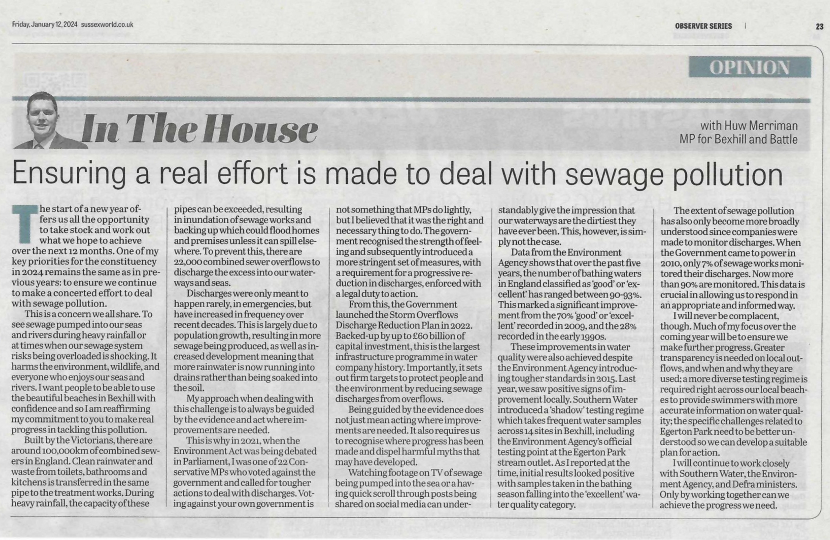
The start of a new year offers us all the opportunity to take stock and work out what we hope to achieve over the next 12 months. One of my key priorities for the constituency in 2024 remains the same as in previous years: to ensure we continue to make a concerted effort to deal with sewage pollution.
This is a concern we all share. To see sewage pumped into our seas and rivers during heavy rainfall or at times when our sewage system risks being overloaded is shocking. It harms the environment, wildlife, and everyone who enjoys our seas and rivers. I want people to be able to use the beautiful beaches in Bexhill with confidence and so I am reaffirming my commitment to you to make real progress in tackling this pollution.
Built by the Victorians, there are around 100,000km of combined sewers in England. Clean rainwater and waste from toilets, bathrooms and kitchens is transferred in the same pipe to the treatment works. During heavy rainfall, the capacity of these pipes can be exceeded, resulting in inundation of sewage works and backing up which could flood homes and premises unless it can spill elsewhere. To prevent this, there are 22,000 combined sewer overflows to discharge the excess into our waterways and seas.
Discharges were only meant to happen rarely, in emergencies, but have increased in frequency over recent decades. This is largely due to population growth, resulting in more sewage being produced, as well as increased development meaning that more rainwater is now running into drains rather than being soaked into the soil.
My approach when dealing with this challenge is to always be guided by the evidence and act where improvements are needed.
This is why in 2021, when the Environment Act was being debated in Parliament, I was one of 22 Conservative MPs who voted against the government and called for tougher actions to deal with discharges. Voting against your own government is not something that MPs do lightly, but I believed that it was the right and necessary thing to do. The government recognised the strength of feeling and subsequently introduced a more stringent set of measures, with a requirement for a progressive reduction in discharges, enforced with a legal duty to action.
From this, the Government launched the Storm Overflows Discharge Reduction Plan in 2022. Backed-up by up to £60 billion of capital investment, this is the largest infrastructure programme in water company history. Importantly, it sets out firm targets to protect people and the environment by reducing sewage discharges from overflows.
Being guided by the evidence does not just mean acting where improvements are needed. It also requires us to recognise where progress has been made and dispel harmful myths that may have developed.
Watching footage on TV of sewage being pumped into the sea or a having quick scroll through posts being shared on social media can understandably give the impression that our waterways are the dirtiest they have ever been. This, however, is simply not the case.
Data from the Environment Agency shows that over the past five years, the number of bathing waters in England classified as ‘good’ or ‘excellent’ has ranged between 90-93%. This marked a significant improvement from the 70% ‘good’ or ‘excellent’ recorded in 2009, and the 28% recorded in the early 1990s. These improvements in water quality were also achieved despite the Environment Agency introducing tougher standards in 2015. Last year, we saw positive signs of improvement locally. Southern Water introduced a ‘shadow’ testing regime which takes frequent water samples across 14 sites in Bexhill, including the Environment Agency’s official testing point at the Egerton Park stream outlet. As I reported at the time, initial results looked positive with samples taken in the bathing season falling into the ‘excellent’ water quality category.
The extent of sewage pollution has also only become more broadly understood since companies were made to monitor discharges. When the Government came to power in 2010, only 7% of sewage works monitored their discharges. Now more than 90% are monitored. This data is crucial in allowing us to respond in an appropriate and informed way.
I will never be complacent, though. Much of my focus over the coming year will be to ensure we make further progress. Greater transparency is needed on local outflows, and when and why they are used; a more diverse testing regime is required right across our local beaches to provide swimmers with more accurate information on water quality; the specific challenges related to Egerton Park need to be better understood so we can develop a suitable plan for action.
I will continue to work closely with Southern Water, the Environment Agency, and Defra ministers. Only by working together can we achieve the progress we need.




